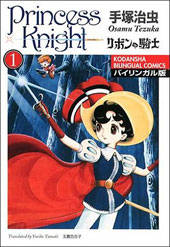by Kory Cerjak
Title: Princess Knight
Author: Osamu Tezuka
Publisher: Vertical
 I’ll give Princess Knight a praise that I haven’t given any other manga I’ve read yet, and it’s this: Princess Knight is the most interesting failure I have ever read. The story of Princess Knight goes that God decides what gender an unborn child will be by giving the child a boy heart or a girl heart. But Tink had already given a child a boy heart when God gives him a girl heart. The child, Sapphire, is born as a girl into a kingdom where only boys can ascend to the throne.
I’ll give Princess Knight a praise that I haven’t given any other manga I’ve read yet, and it’s this: Princess Knight is the most interesting failure I have ever read. The story of Princess Knight goes that God decides what gender an unborn child will be by giving the child a boy heart or a girl heart. But Tink had already given a child a boy heart when God gives him a girl heart. The child, Sapphire, is born as a girl into a kingdom where only boys can ascend to the throne.
This is what’s interesting. Published in 1953 in Kodansha’s Shojo Club magazine, it is perhaps the first foray into feminist manga in Japan, and perhaps the first ever comic to be a true tale of feminist literature. I say it’s a failure because of two main reasons: 1. The boy heart/girl heart concept fails in ways I’ll get into here soon and 2. The power of the females is instilled into them by men. That said, it was extremely daring of Tezuka to do a story like this in 1953, just 33 years removed from the 19th Amendment to the United States Constitution—and a mere eight years removed from the same law coming into play in Japan—and in a country much less known for its progressive gender politics.
Now, the concept of having a “boy heart” or a “girl heart” is interesting in and of itself, it is. But the problem is that when Sapphire is compelled by girl-ish things (like Tink playing a flute or falling in love with the foreign prince), her girl heart takes over and she’s unable to fight as well. This could be construed as the circumstances she was in, but when her boy heart is completely removed by Tink, she completely loses the ability to fight. Why does it have to be her boy heart that gives her the power? Why can’t she simply be a strong character, like Utena in Revolutionary Girl Utena? Sapphire is very much being used as a symbol of female rights in this matter, rather than as a character. The character of Sapphire shouldn’t lose her abilities whether her female or male heart is most prevalent.
Of course, that’s not to say that she does not have some excellent characterization. Where Tezuka fails in feminism, he continues to succeed in both content and character. The story is of a kingdom in strife because the only heir is a daughter in a place where females cannot lead. You can start by hand waving this away and ask why didn’t the current King just change the law, but that’s essentially begging the question. I’ll look past that, but the flaw is there. (It could be that their laws are just so ridiculously rigid; it’s possible considering that it looks like really old England). Sapphire is in love with the foreign prince and the prince, Franz, is in love with the “flaxen-haired maiden,” who Sapphire disguises herself as once. However, Franz hates Prince Sapphire because Sapphire wrongfully imprisoned him for a crime he did not commit. The internal conflict of Sapphire loving the prince, and being both loved and hated in return, is done exceptionally well. It’s very fairy tale-like and a compelling read of a more sophisticated fairy tale than what you’d get out of Grimm’s Tales.
To the second reason, the power of the females is given to them by males. This is inherent in these fairy tale-type stories where a figure of authority gives the power to the higher figure of authority (usually a church official giving the title of King to the next King in a fairy tale story). This isn’t as problematic as my first criticism, but it’s still there. God is this male figure (I wouldn’t typically name this, as God is arguably genderless, but he has the old man beard) while the Devil is a wicked woman—and arguably the only strong female character not given her powers by a male. I think this criticism is most exemplified by the uncle, Duralumin. Rather than him giving power, though, he’s trying to take power away because Sapphire is a female. It’s rather stupid, but never insulting because of the tone of the story.
Princess Knight’s tone is REALLY campy, by the way. It’s especially reminiscent of a fairy tale in this way, where you just have to accept these lofty ideas as fact or you won’t enjoy the literature. The uncle and his aide, Nylon, are the biggest offenders. But they’re both occasionally funny, at least and never overbearing in their camp. The focus is solely on Sapphire and what surrounds her.
It seems to me that it’s the witch’s daughter, Hecate, that actually seems like the strongest female in the cast, though. She’s the witch’s daughter and constantly is defying the witch’s wishes, becoming her own character and person in the process. She, with only a girl’s heart, is doing things indicative of Sapphire’s own boy heart. A true indicator of this is when Hecate takes Sapphire’s girl heart, which her mother stole, to give back to Sapphire. She even pokes fun at “eating the girl heart” herself by saying, “I suddenly want to take up cross stitching.”
The second volume takes my problems with the comic and largely laughs at them. Any problems that I had with the boy heart-girl heart thing are gone once Sapphire starts acting like she used to be even without the boy heart. This is the kind of character growth that I really appreciate in fiction. Sapphire formerly had to depend on her boy heart to fight or to do those stereotypically boy things, but that all went away as she spent more and more time without her boy heart.
The comic actually succeeds more with its message of empowering women here in its second half. The king, now Plastic, finally enacts a decree that allows women to take the throne. Tezuka does this rather sassily, as the announcement is made by saying “From this day onward, all women have the right to vote, to divorce and to beat up the menfolk. All men must surrender unconditionally to women and coexist peacefully.” Now, this message is rather heavy-handed and done in a much more clunky fashion than could have been done. Merely saying that women could ascend to the throne would, in this context, have given the same message in a less overbearing way.
The story itself is a little meandering. It could have ended with the witch being defeated and Sapphire and Franz marrying, but it doesn’t. It continues on to introduce Venus, the Goddess of Beauty. Venus basically takes the role of the now-dead witch and, instead of trying to take Sapphire’s girl heart, tries to take Franz’s love. Venus, it seems, sees Franz as a sort of Paris-like character in that he is too beautiful to be living with humans. The story really adds nothing to the overall plot and is superfluous in the larger scheme of things.
Blood, the pirate captain, turns out to be the best part of the Venus part of the story. His devotion to Sapphire was absolutely beautiful, to the point that he sacrificed himself in order to save Sapphire (which ultimately ends in failure). It’d be a tragedy if it ended that way, but it might have turned out to be a better manga. His ending, while tragic and very well written, was not followed up on in any way. That’s rather frustrating, because his character was good up to this point and could have been done better justice than it was.
The artwork in Princess Knight is pure Tezuka. It’s a little rougher around Tezuka’s usual cleanliness, but it’s still fine. Worse than Apollo’s Song, but better than Attack on Titan. Tezuka’s cartoonish characters make it easy to distinguish everyone. It’s by far the earliest of Tezuka’s work that I’ve read, but his artwork only becomes sharper, not better, as he gets to later in his career.
Tezuka was going for a feminist piece of literature, which fails on several points. It’s ultimately still a good comic that empowers women, but not as good as, say, Utena or Moribito. What it does succeed in is telling a fantasy fairy tale story. This is very reminiscent of the Grimm tales I’ve read, and I found it much more enjoyable than those Grimm tales. I’m glad I was able to read this comic, and it only makes me more interested in Tezuka’s catalogue.
Princess Knight is readily available at your online retailers, Amazon and Right Stuf. I haven’t seen any of the books at my local bookstores, but maybe you’d have better luck at a larger chain that’s NOT in the middle of Iowa. For anime fans, the Princess Knight anime is available from Right Stuf and also easily found from either Amazon or Right Stuf. Those sets, unfortunately, are dub only.

“The character of Sapphire shouldn’t lose her abilities whether her female or male heart is most prevalent.”
Did you forget the part where she overcomes her fear and realizes that she can do the same with only her girl heart as she did with her boy heart, implying that the division between her two identities’ abilities was always only in her head and probably a result of her upbringing?
i agree with the commenter named Vrag. You are missing the whole point of the story… that she realizes that she never needed the “boy heart” to begin with, and the one who was stopping her from fighting was herself because she was brought up to believe that she couldn’t fight if she weren’t a boy.
Of course the story starts sexist because the idea was to build up her character slowly, if this was shown from the beginning the theme of the story wouldn’t have been so strong.
I disagree that the story “failed” i think that it did it’s job perfectly, specially considering it run through the 50s